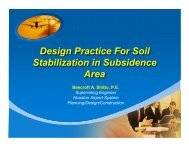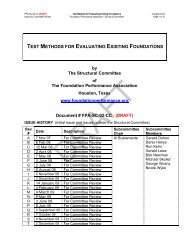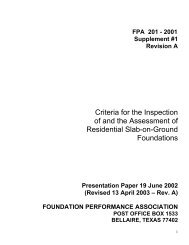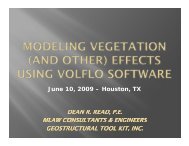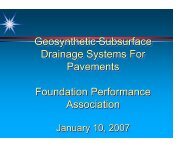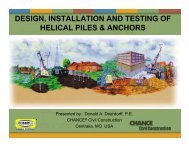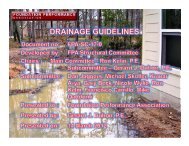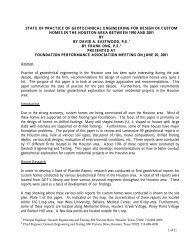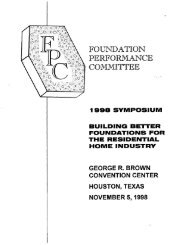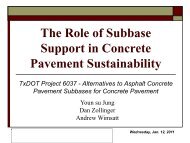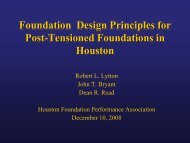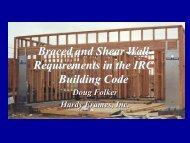Soil-Structure Interaction Seminar - Foundation Performance ...
Soil-Structure Interaction Seminar - Foundation Performance ...
Soil-Structure Interaction Seminar - Foundation Performance ...
You also want an ePaper? Increase the reach of your titles
YUMPU automatically turns print PDFs into web optimized ePapers that Google loves.
Design Plasticity Index 40 and above<br />
Floor Slabs<br />
The floor slabs for foundations supported on drilled footings should consist of (a) structural slabs<br />
with crawl space, (b) slab-on-fill or (c) slab-on-grade.<br />
A structural slab should be used when a minimum risk foundation is to be used. This type of<br />
floor slabs are generally expensive. A slab-on-fill will be less expansive than a structural slab<br />
• with crawl space. The fill thickness in areas where expansive soils are present should be about<br />
18-to 36-inches. The higher fill thickness should be used in areas such as Bellaire, Tanglewood,<br />
New Territory, etc, where highly expansive clays exists (plasticity indices above 50).<br />
The floor slabs can be supported at grade on drilled footings if the subsoils are non-expansive.<br />
All of the subgrade soils should be prepared in accordance to the site preparation section prior<br />
to fill placement.<br />
Void Boxes<br />
Void boxes are historically used under the grade beams to separate the expansive soils from the<br />
grade beams. The void boxes collapse once the underlying expansive soils swell up; thereby<br />
minimizing uplift loads as a result of expansive soils on the grade beams. This can be an<br />
effective feature for reducing potential pressures on grade beams.<br />
In areas of poor drainage, void boxes may act as a pathway for water to travel under a<br />
foundation system. This condition may result in an increase in subsoil moisture contents and<br />
subsequent swelling of the soils. This may result in uplift loads on the floor slabs, and<br />
subsequent distress to the foundation and structural system.<br />
We recommend that the decision on whether or not to use void boxes be made by the<br />
owner/builder after both the positive and negative aspects of this issue are evaluated. Based on<br />
our personal experience with void boxes, it is our opinion that they provide an effective feature<br />
for reducing swell pressure on the grade beams. However, the validity of void box usage is<br />
presently being questioned because of the frequency of observed effects which may outweigh its<br />
benefits.<br />
It should be noted that void boxes should be utilized if a structural slab foundation is used in the<br />
design.<br />
Site Drainage<br />
It is recommended that site drainage be well developed. Surface water should be directed away<br />
from the foundation soils (use a slope of about 5% within 10-feet of foundation). No ponding<br />
of surface water should be allowed near the structure.<br />
GEOTECB ENGINEERING AND TESTING, INC. ____________ _.<br />
13



